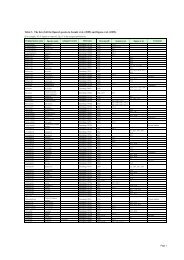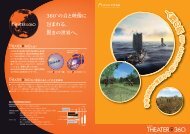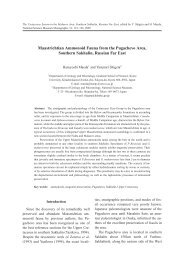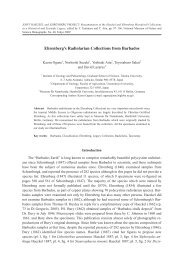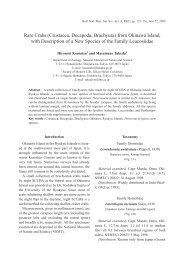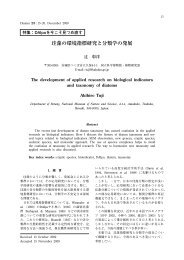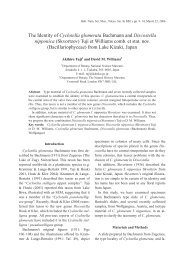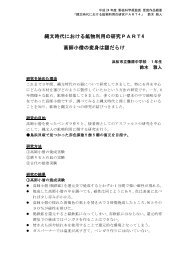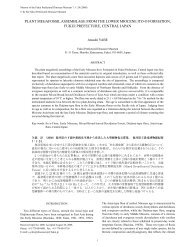First Record of Leucosiid Crabs (Crustacea: Decapoda: Brachyura ...
First Record of Leucosiid Crabs (Crustacea: Decapoda: Brachyura ...
First Record of Leucosiid Crabs (Crustacea: Decapoda: Brachyura ...
- No tags were found...
Create successful ePaper yourself
Turn your PDF publications into a flip-book with our unique Google optimized e-Paper software.
Bull. Natl. Mus. Nat. Sci., Ser. A, 33(2), pp. 61–66, June 22, 2007<strong>First</strong> <strong>Record</strong> <strong>of</strong> <strong>Leucosiid</strong> <strong>Crabs</strong> (<strong>Crustacea</strong>: <strong>Decapoda</strong>: <strong>Brachyura</strong>) fromthe Kermadec Islands, with Description <strong>of</strong> a New SpeciesHironori Komatsu 1 and Masatsune Takeda 21 Department <strong>of</strong> Zoology, National Science Museum, 3–23–1 Hyakunincho, Shinjuku-ku,Tokyo, 169–0073 JapanE-mail: h-komatu@kahaku.go.jp2 Faculty <strong>of</strong> Modern Life, Teikyo Heisei University, 2289–23 Uruido, Ichihara,Chiba, 290–0193 JapanE-mail: takeda-m@thu.ac.jpAbstract Three species <strong>of</strong> leucosiid crabs, Ebalia humilis Takeda, 1977, E. jordani Rathbun,1906, and E. webberi, new species, are recorded from the Kermadec Islands, northern NewZealand. This is the first record <strong>of</strong> leucosiid crabs for the calcinological fauna <strong>of</strong> the Kermadec Islands.Ebalia webberi appears most similar to E. sakaii Takeda & Miyake, 1972 from Japan, butcan be easily distinguished from E. sakaii by the shape <strong>of</strong> the carapace, cheliped, and male firstpleopod.Key words : Kermadec Islands, South Pacific, <strong>Brachyura</strong>, <strong>Leucosiid</strong>ae, new species, new record.IntroductionUnder the special project on Collection Buildingand Natural History Studies in Asia and thePacific Rim, supported by the National Museum<strong>of</strong> Nature and Science (former National ScienceMuseum, Tokyo), a collection <strong>of</strong> brachyurancrabs from the Kermadec Islands was taxonomicallystudied. The results <strong>of</strong> the identificationswere summarized and presented at the SeventhSymposium <strong>of</strong> this project (Takeda and Webber,2004), and a new spider crab <strong>of</strong> the genusAchaeus from the collection was described (Webberand Takeda, 2005). Subsequently 52 speciesin 17 families were reported by Takeda and Webber(2006), but some groups <strong>of</strong> crabs were leftunidentified to species. In this paper, we reportthree species <strong>of</strong> leucosiid crabs, including onenew species, and add these species to the calcinologicalfauna <strong>of</strong> the Kermadec Islands, NewZealand.Measurements, given in millimeters (mm), are<strong>of</strong> the greatest carapace length (including theposterior lobe) and breadth, respectively.Pereiopods are measured along the outer marginfrom ischium to dactylus. The specimens examinedare deposited in the Museum <strong>of</strong> NewZealand Te Papa Tongarewa (NMNZ) and theNational Museum <strong>of</strong> Nature and Science(NSMT).TaxonomyFamily <strong>Leucosiid</strong>aeEbalia humilis Takeda, 1977(Fig. 1A)Ebalia humilis Takeda, 1977: 115, figs. 2 (A, B), 3 (B–D).Material examined. Between Dayrell andChanter Is. (29°15S, 177°50.9W), Herald Islets,Kermadec Is., New Zealand, 31–45 m, 1 ovig. /(3.54.2), NMNZ CR. 011249, coll. RV Acheron,11 Sep. 1976.Remarks. The present specimen agrees withthe original description in general morphology,but compared with the holotype, ovigerous female(NSMT-Cr 5489) from the Ogasawara Islands,southern Japan, the ornamentations <strong>of</strong> thecarapace and chelipeds are weak. That is, tuber-
62 Hironori Komatsu and Masatsune TakedaFig. 1. A, Ebalia humilis Takeda, 1977, ovig. / (3.54.2 mm; NMNZ CR. 011249). B, Ebalia jordani Rathbun,1906, / (15.415.7 mm; NMNZ CR. 011250).cles on the pterygostomian region <strong>of</strong> the carapaceand on the chelipedal merus are absent, anda projection on the metabranchial margin isweak. These differences are shared with theparatype, female (NSMT-Cr 5490), and may be amorphological feature <strong>of</strong> a full-grown femalespecimen.Distribution. Ogasawara Islands and KermadecIslands, occurring at depths <strong>of</strong> 31–84 m.Ebalia jordani Rathbun, 1906(Fig. 1B)Ebalia jordani Rathbun, 1906: 889, pl. 15(3).Not Ebalia jordani: Yokoya, 1933: 121 (E. nudipesSakai, 1963).Material examined. East <strong>of</strong> Chanter Islets(29°15.5S, 177°50W), Raoul I., Kermadec Is.,New Zealand, 402–366 m, 1 / (15.415.7),NMNZ CR. 011250, coll. RV Acheron, 28 Oct.1975.Remarks. This is the first record <strong>of</strong> thisspecies since the original description, and extremelyextends its geographical distributionfrom Hawaii to the South Pacific. The presentspecimen agrees well with the original descriptionin general morphology, but the dactyli <strong>of</strong>ambulatory legs are distinctly setose. This characterwas not described and illustrated in theoriginal description.Distribution. Hawaiian Islands and KermadecIslands, occurring at depths <strong>of</strong> 55–385 m.Ebalia webberi sp. nov.(Figs. 2, 3)Material examined. Holotype: ? (3.74.1),NMNZ CR. 011251, between MeteorologicalStation and Hutchinson Bluff (ca. 29°10S, 177°50W), Raoul I., Kermadec Is., New Zealand,beam trawl, 146–110 m, coll. RV Acheron, 4 Apr.1973.Description. Carapace (Fig. 2A) subrhomboidalin general outline, 1.1 times broader thanlong; upper surface convex dorsally, uniformlycovered with acute granules, granules elongatearound margin. Frontal region moderately produced,shallowly concave medially; margin dividedinto 4 lobes with shallow notches. Gastro-cardiacregion raised, not divided from each other,with pair <strong>of</strong> tubercles on gastric region and tubercleon cardiac region; gastric tubercles directeddorsally; cardiac tubercle directed dorsally, abouttwice as large as gastric tubercles. Intestinal regionprotuberant, with subapex tubercle; margintriangularly projected beyond posterior lobes.Hepatic region weakly defined; margin not protrudedfrom general outline <strong>of</strong> carapace. Pterygostomianmargin diverged, obtusely angled atposterior 0.3 with small cluster <strong>of</strong> granules,
<strong>Leucosiid</strong> <strong>Crabs</strong> from the Kermadec Islands 63Fig. 2. Ebalia webberi sp. nov., holotype, ? (3.74.1 mm; NMNZ CR. 011251). A, B, dorsal and ventral views,respectively.
64 Hironori Komatsu and Masatsune Takedaforming right angle with branchial margin.Branchial region sloping antero-laterally, with 3small clusters <strong>of</strong> granules on mid portion; marginroundly convex in anterior half, obliquely convergentin posterior half, with acute triangular projectionon midlength and right-angled triangularprojection on posterior 0.2. Posterior margin separatelybilobed, lobes obtusely triangular withrounded tip.Ocular peduncle very short. Orbit with 2straight fissures on dorsal ro<strong>of</strong>, with V-shapednotch on infraorbital margin; orbital hiatusclosed with second segment <strong>of</strong> antenna. Antennulefolded into slightly oblique fossa; basal segmentoccupying ventral 0.6 <strong>of</strong> fossa, not coveredwith granules. Antennal basal segment transverselyovate, second segment subrectangular.Afferent channel with V-shaped notch on anteriormargin.Mandible well calcified, cutting edge triangularin outline, pointed medially; endopod palp 3-segmented. Maxillule: endopod small, triangular.Maxilla: coxal and basial endites missing; endopodtriangular, with rounded tip; exopod(scaphognathite) longitudinally expanded intooval structure, entirely fringed with short,plumose setae. <strong>First</strong> maxilliped: exopod bearingflagellum with some weakly plumose, terminalsetae. Second maxilliped: exopod bearing flagellumwith some terminal setae; exodite absent.Third maxilliped (Fig. 3a, b) covered with acutegranules <strong>of</strong> various sizes; basis fused with ischium,but with remnant suture on internal surface;ischium subsquamate; merus gently bent dorsallyin situ, as long as ischium along mesial margin;propodus and dactylus with distally denticulatesetae along distal and inner margins,respectively; exopod subsquamate, scarcelytapering distally, rounded at tip, fringed withshort plumose setae on lateral margin; internalexopodal ridge scarce, with moderately longsetae along ridge; epipod reduced, not well calcified;podobranch absent.Cheliped (Fig. 3c) slender, 1.9 times as long ascarapace, covered with granules <strong>of</strong> various sizes;coxal condyle stilliform; merus subcylindrical,with two triangular projections on outer margin;carpus convex; palm convex dorsally, arcuate oninner margin, with triangular projection on proximal0.3 <strong>of</strong> outer margin; fingers slender, finelydentate on both cutting edges, without gap whenclosed; movable finger about 1.4 times as long aspalm.Ambulatory legs (Figs. 2, 3d) <strong>of</strong> moderatelength, covered with minute granules exceptdactyli, granules along margins acute, sparselyfurnished with short plumose setae; coxalcondyles rounded; meri, carpi, and propodi subcylindrical;dactyli subconical, smooth, withinconspicuous dactylo-propodal locks on proximalends <strong>of</strong> dorsal surfaces.Thoracic sternites (Fig. 3e): 1st to 4th sternitesfused with each other, with partial suture between3rd and 4th sternites, covered with acutegranules <strong>of</strong> various sizes; 5th to 8th sternites coveredwith vesicular granules, separated from eachother by medially interrupted sutures; episternitesnot divided; abdominal cavity reaching nearbyanterior end, roundly concave on distal part soas tip <strong>of</strong> first pleopod fit into this concavity; medianfissure absent.Abdomen (Figs. 2B, 3f) covered with vesiculargranules <strong>of</strong> various sizes; 1st segment short,transversely subrectangular, concealed beneathcarapace for most part; 2nd segment very short,transversely subrectangular, medially interrupted;main fused section composed <strong>of</strong> 3rd to 5th segments,elongate trapezoidal, weakly constrictedat distal 0.4, with large, acute triangular toothnearby distal margin, tooth directed ventrally; telsontriangular.Male first pleopod (Fig. 3g, h) robust, roundlydilated and translucent in distal half, with 2 acuteprocesses on sternal surface. Male second pleopod(Fig. 3i) short, about 0.5 times as long asfirst one, subcylindrical, crested; distal jointtubular, laterally pointedEtymology. This species is dedicated to Mr.R. Webber <strong>of</strong> the Museum <strong>of</strong> New Zealand TePapa Tongarewa, who takes responsibility for themanagement <strong>of</strong> the calcinological collections.Remarks. Ebalia webberi, new species, is
<strong>Leucosiid</strong> <strong>Crabs</strong> from the Kermadec Islands 65Fig. 3. Ebalia webberi sp. nov., holotype, ? (3.74.1 mm; NMNZ CR. 011251). a, b, right third maxilliped, externaland internal views, respectively; c, left chela, dorsal view; d, left fourth ambulatory leg, dorsal view; e,male thoracic sternites, ventral view; f, abdomen (first and second segments omitted), ventral view; g, h, rightfirst pleopod, external and internal views, respectively; i, right second pleopod, external view. Scales for a, b,d, g–i0.5 mm; scales for c, e, f1 mm.most closely resembles to E. sakaii Takeda &Miyake, 1972 in the ornamentation <strong>of</strong> the carapace,but can be distinguished from E. sakaii bythat the dorsal surface <strong>of</strong> carapace is coveredwith acute granules (flat-topped granules in E.sakaii), projections <strong>of</strong> the branchial margin <strong>of</strong> thecarapace and the chelipedal palm are weak (distinctin E. sakaii), the male sternum roundly concave(not concave in E. sakaii), the male firstpleopod roundly dilated in distal part (distallyacute in E. sakaii), and the distal joint <strong>of</strong> themale second pleopod is tubular (filiform in E.sakaii).Ebalia webberi is also similar to E. dimorphoidesSakai, 1963, but readily distinguishedfrom E. dimorphoides by that the male first pleopodis robust (slender in E. dimorphoides) andthe male second pleopod is 0.5 times as long asfirst pleopod (as long as first pleopod in E. dimorphoides).Distribution. Known only from the KermadecIslands, occurring at depths <strong>of</strong> 110–146 m.
66 Hironori Komatsu and Masatsune TakedaAcknowledgmentsWe wish to express our cordial thanks to Mr.R. Webber <strong>of</strong> the Museum <strong>of</strong> New Zealand TePapa Tongarewa, who kindly arranged the specimensfor study.LiteratureRathbun, M. J., 1906. The <strong>Brachyura</strong> and Macrura <strong>of</strong> theHawaiian Islands. Bulletin <strong>of</strong> the United States FishCommission, 23: 829–930, pls. 821–824.Sakai, T., 1963. Description <strong>of</strong> two new genera and fourteennew species <strong>of</strong> Japanese crabs from the collection<strong>of</strong> His Majesty the Emperor <strong>of</strong> Japan. <strong>Crustacea</strong>na, 5:213–233.Takeda, M., 1977. <strong>Crabs</strong> <strong>of</strong> the Ogasawara Islands, V. Acollection made by dredging. Memoirs <strong>of</strong> the NationalScience Museum, Tokyo, (10): 113–140, pls. 112–117.Takeda, M. and S. Miyake, 1972. New crabs from the seaaround the Tsushima Islands. Bulletin <strong>of</strong> the NationalScience Museum, Tokyo, 15: 253–265.Takeda, M. and R. Webber 2004. <strong>Crabs</strong> from the KermadecIslands. Seventh Symposium on CollectionBuilding and Natural History Studies in Asia and thePacific Rim. Abstracts, p. 4. National Science Museum,Tokyo.Takeda, M. and R. Webber, 2006. <strong>Crabs</strong> from the KermadecIslands in the South Pacific. In: Y. Tomida, T.Kubodera, S. Akiyama and T. Kitayama (eds.), Proceedings<strong>of</strong> the Seventh and Eighth Symposia on CollectionBuilding and Natural History Studies in Asiaand the Pacific Rim. National Science Museum Monographs,(34): 191–237.Webber, R. and M. Takeda, 2005. A new spider crab <strong>of</strong>the genus Achaeus (<strong>Crustacea</strong>, <strong>Decapoda</strong>, <strong>Brachyura</strong>)from the Kermadec Islands. Bulletin <strong>of</strong> the NationalScience Museum, Tokyo, Series A, 31: 45–50.Yokoya, Y., 1933. On the distribution <strong>of</strong> decapod crustaceansinhabiting the continental shelf around Japan,chiefly based upon the materials collected by S. S.Soyo-Maru, during the year 1923–1930. Journal <strong>of</strong> theCollege <strong>of</strong> Agriculture, Tokyo Imperial University, 12:1–225.



